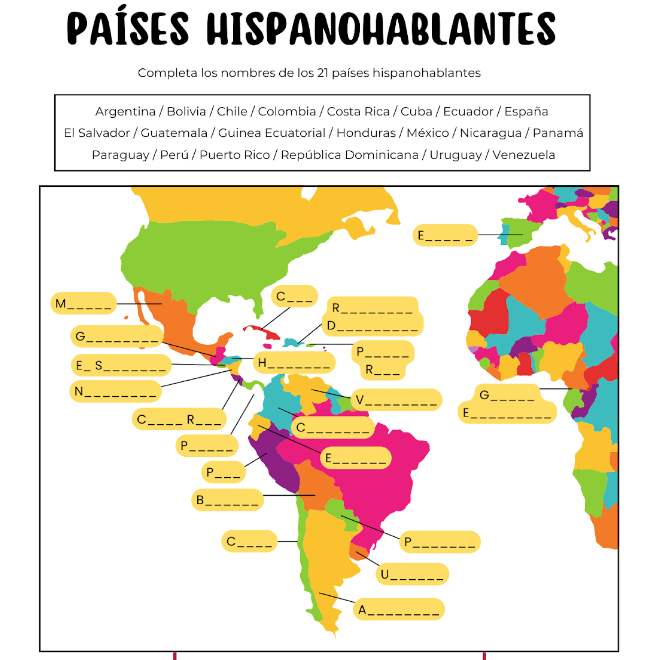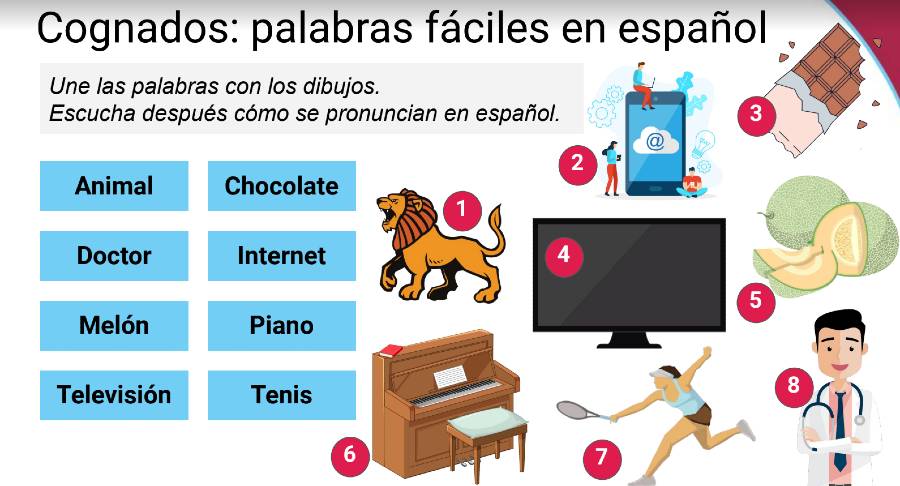Avoid just getting straight to content.
Are you familiar with that sentence?
Our Admin keeps saying it all the time in the final days before school starts.
But we teach Spanish.
If we can’t go straight to content… What do we do?
Wait a week to start using the target language? That doesn’t make sense.
Here are some ideas and resources that we use in our Spanish 1 (beginner's) classes, and that will sure help you get ready for a successful start.
For ideas and activities for intermediate and advanced students, check out this post.
¡Y buena suerte!
Day 1
It's the first day!
Lots of new faces.
You don't want to scare students starting too strong.
But you don't want to use only their native language.
This is what my first day looks like:
1 Introduce myself.
2 Check for understanding.
3 Where Spanish is spoken.
4 Game and first prices.
1 Let's begin.
I tell my students there will be times they won't understand me.
And that's ok, totally normal when you learn a new language.
But I need some feedback to know whether they're understanding me.
So this is what I do after introducing myself (and that takes a while when your last name is Mediavilla. I use Google slides to explain how to pronounce my name, what it means, where I'm from and I talk a bit about my family and my background).
2 I write "¿Entendido?" on the board.
I explain this is the sentence I'll use to check for understanding through the whole year.
If they understand what I just said, they reply "Sí, señor" (I write it on the board, and I also use this opportunity to introduce the "Ñ", the only character in the Spanish language that is unique).
If they don't understand me, they just raise their hand.
Then we give it a try.
¿Entendido?
3 After introducing myself and explaining how I check for understanding, I ask them how many countries speak Spanish in the world.
The goal is to tell them this is not a secret language we're going to speak among ourselves.
It's a very powerful tool.
It'll allow them to communicate with millions of people.
It opens opportunities.
Travel opportunities.
Job opportunities.
Love and friendship opportunities.
Students raise their hands.
They start saying numbers.
Crazy numbers sometimes.
I guide them (saying more or less) until somebody says 21
4 Then I move to the free-warm up activity called Países hispanohablantes, in the Hispanidad y países section.
I like doing this activity in small groups (3-4 students).
I print a copy of the PDF for each group (only the second page of the document, of course).
I explain that the 21 countries that speak Spanish as an official language are on that paper.
There are 9 that do not belong to that group: because they are not Spanish-speaking countries, o because they are not countries.
I use my Smartboard to give them an example. Bueno, we do it together.
I ask them if Argentina is a Spanish-speaking countries.
We agree that sí, it is.
I ask about Barcelona.
I explain that people in Barcelona speak Spanish, but it isn't a country, it's the second biggest city in Spain.
So we have an example of a Spanish-speaking country (Argentina) and an example of a place that doesn't belong to the list of 21 (Barcelona).
Their job is to find the other 20. ¿Entendido?
Then, they begin. I encourage them to take their best guess if they don't know.
It's ok to make mistakes.
I give them some time to finish.
We check the answers using the honor system.
They tell me how many they got right.
I give a small price to the winner and that's how the first day ends.
It was an easy, relaxing and fun day.
We used some Spanish.
They played a game.
And they're ready for Day 2.
PS: I know this plan doesn't follow the standard procedure, which is usually to get to know your students. I do that in my intermediate and advanced classes, but not with beginners. I of course take attendance on the first day and try to learn their names, but I wait a couple of classes before I start to know more about them. For instance, when we learn the verb gustar is when we talk about their hobbies. In Spanish. And the same for family, where they live... The Spanish I syllabus gives us lots of opportunities to get to know our students well, one topic at a time.
Day 2
On the second day I start setting a class routine.
As they walk in every day, they'll have to work on a warm-up activity.
There are two kinds of warm-up activities I use: paper and the Smartboard.
If it's on paper, they need to grab a copy as they enter the class.
If it's on the Smartboard, well, just look at it.
Today, it's on paper. It looks like this:

I tell students where I place warm-up papers (on a table by the entrance).
They must grab one when they walk in and start working on it.
They of course didn't know that on the second day. So I ask them to go to the table and get a copy.
I play some music in the background to help them focus and make the atmosphere happier.
I like Oye, by Sonora Dinamita, for that second class.
Join Bablingua to get a copy of that first worksheet and access to our whole catalog
It's a very simple warm-up activity, just make sure you give them the right page (the one with the map and the word bank) and clear directions.
I use the bottom part of the warm-up to explain that the U.S.A. is the second country in the world in number of Spanish-speakers.
Spanish is not its official language, but more people speak Spanish in the U.S. than in any other country in the world but Mexico.
How do we move forward from here?
This is what I do: I ask them which words they already know in Spanish, and use some of the answers to introduce cognates.
The above document has a word search to help you with that, or you can use it as the warm-up activity of day 3.
These are not random cognates. I'll get back to them when we learn the verb gustar with the ¿Dígame? El tiempo libre lesson.
Students will use those cognates to make sentences with gustar:
Me gusta mucho la pizza.
Me gustan los animales.
No me gusta el tenis.
No me gustan los exámenes.
Day 3
I start teaching in a more structured way.
My first lesson is Conversación básica.
I love it because my students are going to quickly make their first full conversations.
It's an achievement for them, it gives them joy and hope. They can do it!
The lesson includes this warm-up activity, or you can finish the word search from the first day as today's warm-up (it's a super hard word search, don't expect them to finish it by themselves!)
If you use the warm-up activity from the Conversación básica lesson, then go over the second kind of warm-ups: those you project on the Smartboard.
Students should write on their notebooks the Spanish words, and the numbers they match.
This lesson is fun!
Students will watch their first Bablingua video and they'll use it as a model to make their own conversations.
It'll be their first role-play activity, and they'll love it.
Everything is easier from that point.
Students are familiar with the routines and ready to build on their Spanish.
It'll be an awesome year.
¿Entendido?




One Comment on “Los primeros días de clase”
espero leer la leccion para usarla este ano